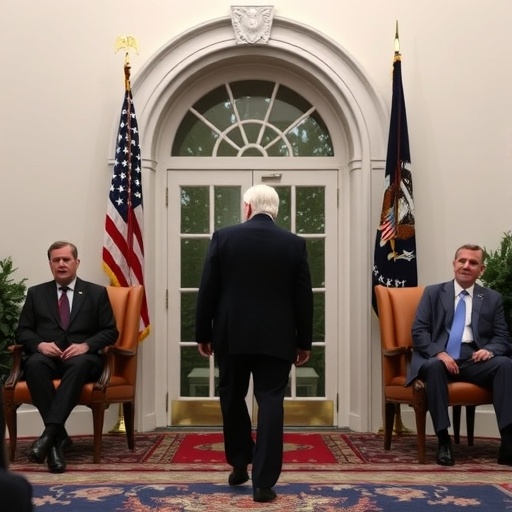Government shutdown Hits Fourth Week: Senate Republicans Convene with Trump at White House Amid Healthcare Subsidies Standoff
As the Government shutdown stretches into its fourth grueling week, Senate Republicans are descending on the White House today for a high-stakes meeting with President Trump, signaling a unified front against mounting pressure for compromise. With no end in sight to the impasse over healthcare subsidies, hundreds of thousands of federal workers are staring down the barrel of a second missed paycheck, amplifying the human cost of Washington’s partisan gridlock.
- Senate Republicans Rally for Unity in Face of Shutdown Pressure
- Federal Workers Endure Mounting Hardships from Prolonged Shutdown
- Healthcare Subsidies Emerge as Core Battleground in Bipartisan Deadlock
- White House Strategy Session Signals Hardline Stance on Shutdown Resolution
- Outlook Darkens: Economic Fallout and Path to Shutdown Endgame
The gathering, described by White House officials as a “strategy session for victory,” comes at a critical juncture. Lawmakers from both sides of the aisle have traded barbs for weeks, but today’s Republican huddle underscores the deepening divide, particularly as Democrats push for protections in healthcare funding that Republicans view as non-negotiable giveaways. This shutdown, now the longest in U.S. history, has furloughed over 800,000 federal employees and forced another 1.2 million to work without pay, according to estimates from the Office of Personnel Management.
President Trump, speaking briefly to reporters en route to the White House, reiterated his stance: “We’re not budging on the essentials. Healthcare subsidies can’t be a blank check for failed policies.” His words set the tone for what insiders predict will be a combative afternoon, as Senate Republicans seek to bolster their resolve amid growing public frustration.
Senate Republicans Rally for Unity in Face of Shutdown Pressure
Senate Majority Leader Mitch McConnell led a convoy of GOP senators into the White House grounds this morning, their arrival timed to project solidarity with Trump amid whispers of internal dissent. Sources close to the meeting say the agenda includes not just the immediate shutdown crisis but also long-term strategies to counter Democratic demands on healthcare subsidies.
Key attendees include Senators Lindsey Graham of South Carolina, Ted Cruz of Texas, and Mike Lee of Utah, all vocal Trump allies who have publicly decried the shutdown as a “Democrat-engineered disaster.” Graham, in a pre-meeting statement on Fox News, emphasized the party’s commitment: “We’re here to back the president 100%. This isn’t about politics; it’s about protecting American taxpayers from unchecked spending on subsidies that prop up Obamacare remnants.”
The unity display is no small feat. Polling from Gallup shows Republican approval ratings dipping to 38% amid the shutdown’s fallout, with independents particularly souring on the GOP’s handling. Yet, the White House meeting aims to quash any notions of fracture. A senior Republican aide, speaking anonymously, revealed that Trump plans to outline a “grand bargain” framework that ties border security enhancements to limited healthcare concessions, though details remain closely guarded.
Historically, such intra-party summits have proven pivotal. During the 2013 shutdown, a similar Republican conclave at the Capitol helped solidify opposition to the Affordable Care Act, leading to a 16-day stalemate. This time, with healthcare subsidies at the epicenter—specifically, the $1.5 billion in annual funding for low-income insurance premium assistance—the stakes feel even higher. The Congressional Budget Office projects that without resolution, these subsidies could lapse by mid-February, affecting over 6 million Americans reliant on them.
Federal Workers Endure Mounting Hardships from Prolonged Shutdown
While politicians convene in air-conditioned comfort, the real toll of the Government shutdown is unfolding in living rooms across America. Take Sarah Jenkins, a 42-year-old IRS auditor from Virginia, one of the 800,000 furloughed workers. “This is our second paycheck gone,” she told reporters outside her home. “My kids don’t understand why we can’t afford the school supplies they need. It’s heartbreaking.”
Jenkins’ story is echoed nationwide. The Treasury Department reports that federal employees have already forgone $2.3 billion in wages this month alone, with non-essential services from national parks to passport offices grinding to a halt. In Alaska, Coast Guard personnel are working without pay to maintain search-and-rescue operations, while Smithsonian curators in Washington D.C. watch dust accumulate on priceless artifacts.
Economists warn of broader ripples. A report from the U.S. Travel Association estimates the shutdown has already cost the economy $7 billion, with tourism hotspots like Yosemite National Park shuttered and losing $100,000 daily. Food pantries in federal worker-heavy areas, such as Northern Virginia, have seen a 40% uptick in demand, according to Feeding America.
Amid the hardship, some workers are turning to side gigs. Uber reports a 25% surge in driver sign-ups from D.C. zip codes, while platforms like TaskRabbit note increased bookings for handyman services from laid-off engineers. But for many, like Air Traffic Controller Mark Ruiz, who must report to duty unpaid, the strain is psychological. “We’re patriots, but this feels like betrayal,” Ruiz said in an interview with CNN. “How long can we keep going?”
The shutdown’s impact extends to contractors too. Boeing and Lockheed Martin, major government vendors, have furloughed thousands, with potential layoffs looming if the impasse drags into March. The Partnership for Public Service, a nonpartisan advocacy group, has launched emergency funds, distributing $5 million in grants to affected families, but it’s a drop in the bucket against the $11 billion annual payroll for federal civilians.
Healthcare Subsidies Emerge as Core Battleground in Bipartisan Deadlock
At the heart of this government shutdown lies a fierce debate over healthcare subsidies, a flashpoint that’s transformed routine budget negotiations into a partisan war. Democrats, led by House Speaker Nancy Pelosi, insist on restoring full funding for the cost-sharing reductions under the Affordable Care Act, arguing it’s essential for affordable coverage. Republicans, however, see it as an expansion of government overreach, with Trump vowing to veto any bill that includes what he calls “socialist handouts.”
The subsidies in question, enacted in 2017 via executive action after congressional repeal efforts failed, provide $7 billion annually to insurers to lower out-of-pocket costs for low-income enrollees. Without them, premiums could spike by 20%, per Kaiser Family Foundation analysis, hitting 7 million marketplace shoppers hardest. Senate Democrats, including Elizabeth Warren and Bernie Sanders, have flooded the floor with amendments to protect these funds, but McConnell’s rules have bottled them up.
Trump’s rhetoric has only intensified the standoff. In a tweetstorm yesterday, he accused Democrats of “holding the government hostage over illegal immigrant healthcare,” linking the subsidies to broader immigration debates—a narrative that resonates with his base but alienates moderates. White House Press Secretary Sarah Sanders echoed this in her briefing: “The president is open to compromise, but not at the expense of fiscal responsibility. Healthcare subsidies must be reformed, not rubber-stamped.”
Behind the scenes, negotiations have crumbled repeatedly. A January 10th offer from Senate Republicans to fund the government through March in exchange for subsidy caps was rebuffed by Democrats, who demand permanence. Bipartisan groups like the Problem Solvers Caucus have floated middle-ground proposals, such as phased funding tied to cost controls, but partisan loyalty has stifled progress.
Public health experts are alarmed. Dr. Atul Gawande, a surgeon and former Obama advisor, warned in a New York Times op-ed: “This shutdown isn’t just political theater; it’s a public health crisis. Delays in subsidy payments could lead to untreated conditions and higher emergency room visits, straining an already overburdened system.” Indeed, early data from the CDC shows a 15% rise in uninsured visits to clinics in shutdown-affected states like California and New York.
White House Strategy Session Signals Hardline Stance on Shutdown Resolution
Inside the White House’s Cabinet Room, the atmosphere was charged as Trump and Senate Republicans mapped out their next moves. Leaked notes from the meeting, obtained by Politico, reveal discussions centered on leveraging the shutdown’s pain to force Democratic concessions on healthcare subsidies. Trump reportedly urged senators to “hold the line,” promising campaign support for those who do.
Senator Cruz, emerging briefly for a statement, was bullish: “This meeting was productive. We’re united, and the American people will see that Democrats are the obstructionists here.” But not all feedback was glowing. Moderate Republicans like Susan Collins of Maine have privately expressed concerns, with Collins telling MSNBC: “We need a path forward that doesn’t punish innocent workers. Healthcare access shouldn’t be a bargaining chip.”
The session also touched on public messaging. Aides are crafting a media blitz, including Trump rallies in shutdown-hotspot states like Ohio and Pennsylvania, to frame the narrative around Democratic “extremism.” Meanwhile, the White House is coordinating with conservative think tanks like the Heritage Foundation to produce reports decrying the subsidies as “wasteful entitlements.”
Yet, cracks in the facade are showing. A Quinnipiac poll released today finds 54% of Americans blame both parties equally, but 32% point fingers at Trump—a slight uptick from last week. Senate Republicans are acutely aware, with some pushing for a short-term funding bill to buy time. However, Trump’s influence remains dominant, as evidenced by his post-meeting tweet: “Great energy with our Senators! Shutdown ends when Dems come to table on real reforms.”
The meeting’s outcomes could ripple through upcoming votes. The House has scheduled a procedural vote on a clean funding bill for tomorrow, which Republicans plan to filibuster, prolonging the shutdown. Legal experts note that if it hits 35 days—the length of the 2018-2019 shutdown—courts may intervene on backpay issues, adding another layer of uncertainty.
Outlook Darkens: Economic Fallout and Path to Shutdown Endgame
As the dust settles from the White House powwow, the path forward looks thornier than ever. Moody’s Analytics forecasts that each additional week of shutdown could shave 0.1% off U.S. GDP growth, potentially tipping the economy toward recession if unresolved by Valentine’s Day. Small businesses near federal installations, from D.C. delis to Colorado ski resorts, are reporting 30% revenue drops, per the National Federation of Independent Business.
Public sentiment is shifting toward urgency. A Monmouth University survey shows 62% of voters want Congress to end the shutdown regardless of policy wins, a sentiment bipartisan in its frustration. Veterans’ groups, impacted by delayed VA benefits, have mobilized protests, with the American Legion calling for immediate action.
Looking ahead, the next flashpoint is a February 15th debt ceiling deadline, which could compound the crisis. Bipartisan whispers suggest a possible “grand compromise” bundling shutdown resolution with immigration reforms and subsidy tweaks, but trust is in short supply. House Democrats are preparing contempt proceedings against administration officials for withholding shutdown impact data, escalating tensions.
For federal workers like Jenkins and Ruiz, the wait continues. Community support networks are expanding—churches in Maryland are hosting free legal clinics for debt relief—but the emotional toll mounts. As Trump and Senate Republicans dig in, the question lingers: Will unity yield breakthrough, or deepen the divide? With healthcare subsidies hanging in the balance, the nation’s fiscal and social fabric frays further, demanding resolution before irreparable damage sets in.
In the coming days, watch for Senate floor action and potential Trump interventions. If history is any guide—from the 1995-1996 shutdowns to more recent clashes—compromise often emerges from exhaustion, but not without scars. For now, the government shutdown endures, a stark reminder of democracy’s delicate balance.










